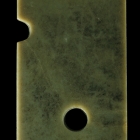J.J. Lally & Co., Oriental Art / New York City, New York
Menu18.
A GREEN JADE CEREMONIAL BLADE (GUI)
Late Neolithic Period, Early 2nd Millennium B.C.
of long narrow shape, thicker at the tang and thinning very gradually towards the slightly flared cutting edge, drilled from one side with a small hole near the butt with partially unfinished rounded end, cut with notches to the edges on either side of the hole and with a well finished semicircle cut out further down on one edge, very finely polished all over to a smooth surface which feels soft to touch, the dark olive green stone with subtle natural markings; Chinese fitted wood box with silk lining.
Length 11 1⁄4 inches (28.6 cm)
Provenance
From the Collection of Eugene Meyer (1875-1959) and
Agnes E. Meyer (1887-1970)
Compare three Neolithic jade gui blades in the collection of the Palace Museum, Beijing illustrated in Gugong bowuyuan cangpin daxi: yuqi bian (Compendium of Collections in the Palace Museum: Jade), Vol. 1, Neolithic Age, Beijing, 2011, p. 191, no. 184, described as Longshan Culture; on p. 200, no. 194, described as Qijia Culture; and on p. 247, no. 246, described as Neolithic period.
Compare also the late Neolithic jade gui blade of smaller size, cut with a small semicirclular void on the edge of one side, excavated from a Longshan burial site at Shimao, Shenmu county, Shaanxi province, now in the collection of the Shaanxi History Museum, illustrated in Yu hun guo hun: yuqi, yu wenhua, Xia dai Zhongguo wenming zhan (Soul of Jade, Soul of the Nation: Exhibition of Jade, Jade Culture, and the Xia Dynasty Civilization in China), Hangzhou, 2013, p. 195.
新石器時代晚期 玉圭 長 28.6 厘米
出處 邁爾夫婦舊藏
